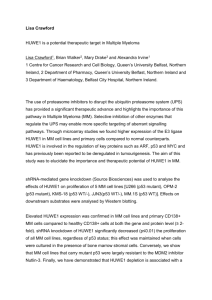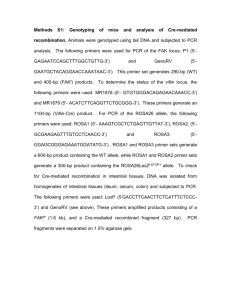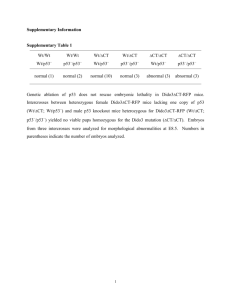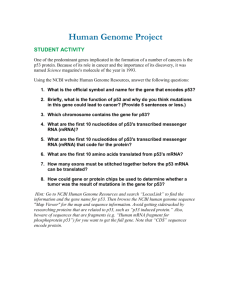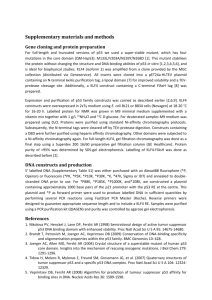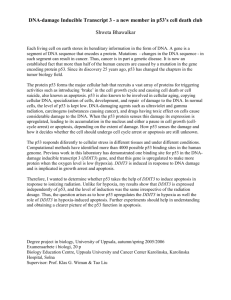Supplementary Information (doc 48K)
advertisement
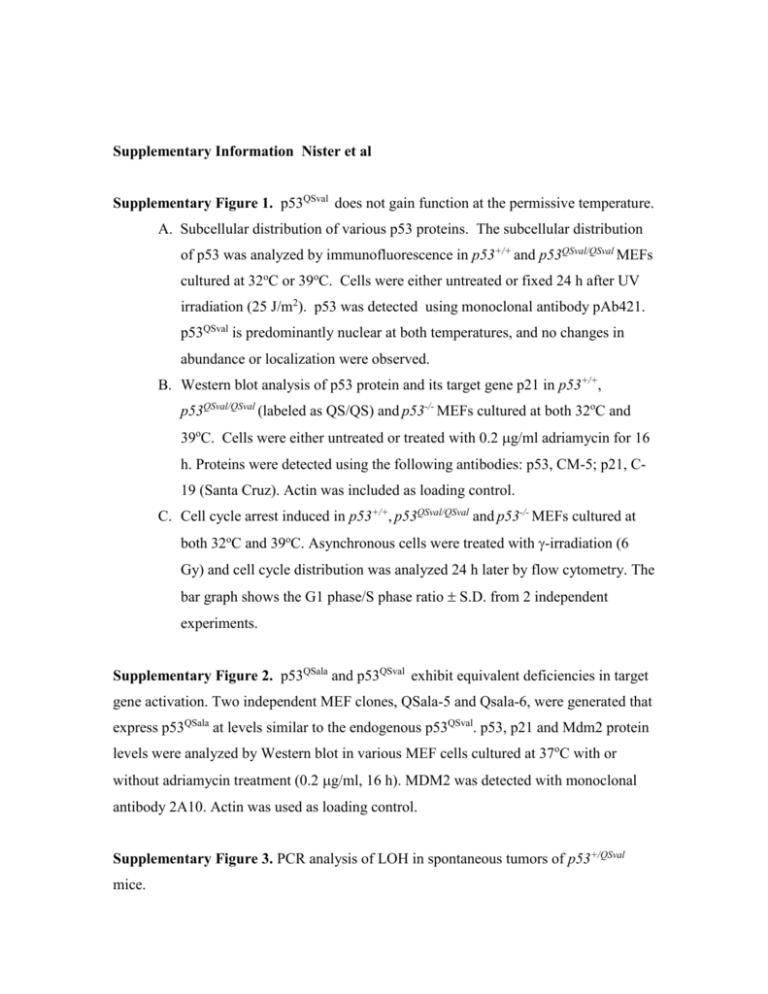
Supplementary Information Nister et al Supplementary Figure 1. p53QSval does not gain function at the permissive temperature. A. Subcellular distribution of various p53 proteins. The subcellular distribution of p53 was analyzed by immunofluorescence in p53+/+ and p53QSval/QSval MEFs cultured at 32oC or 39oC. Cells were either untreated or fixed 24 h after UV irradiation (25 J/m2). p53 was detected using monoclonal antibody pAb421. p53QSval is predominantly nuclear at both temperatures, and no changes in abundance or localization were observed. B. Western blot analysis of p53 protein and its target gene p21 in p53+/+, p53QSval/QSval (labeled as QS/QS) and p53-/- MEFs cultured at both 32oC and 39oC. Cells were either untreated or treated with 0.2 g/ml adriamycin for 16 h. Proteins were detected using the following antibodies: p53, CM-5; p21, C19 (Santa Cruz). Actin was included as loading control. C. Cell cycle arrest induced in p53+/+, p53QSval/QSval and p53-/- MEFs cultured at both 32oC and 39oC. Asynchronous cells were treated with -irradiation (6 Gy) and cell cycle distribution was analyzed 24 h later by flow cytometry. The bar graph shows the G1 phase/S phase ratio S.D. from 2 independent experiments. Supplementary Figure 2. p53QSala and p53QSval exhibit equivalent deficiencies in target gene activation. Two independent MEF clones, QSala-5 and Qsala-6, were generated that express p53QSala at levels similar to the endogenous p53QSval. p53, p21 and Mdm2 protein levels were analyzed by Western blot in various MEF cells cultured at 37oC with or without adriamycin treatment (0.2 g/ml, 16 h). MDM2 was detected with monoclonal antibody 2A10. Actin was used as loading control. Supplementary Figure 3. PCR analysis of LOH in spontaneous tumors of p53+/QSval mice. A. Representative PCR analyses for genotyping of mice using tail DNA and an allele-specific PCR protocol. Specific products of identical lengths (227 bp) were obtained as follows: In p53+/+, only P53w1-P53-4 (w) resulted in product; in p53QSval/QSval, only P53m1-P53-4 (Q) gave a product; and in p53+/QSval, both reactions resulted in products. B. Allele-specific PCR to detect LOH in tumors of heterozygous mice. The figure shows a subset of the results obtained with paired tumor (T) and normal (N) tissues. DNA was prepared from microdissected cryosections. Tumors 19F3QS and 66F4QS showed a major reduction of signal for the wild type allele (w) compared to mutated allele (Q) in the tumor tissue, indicating LOH in these two samples. Supplementary Results Distribution of genotype in progeny from heterozygous crossings From heterozygous crosses in the p53QSval colony, 25% of the mice were wild type, 19% were homozygous and 56% were heterozygous (n=96), while heterozygous crosses in the p53 null colony resulted in 27% wild-type, 15% homozygous null, and 58% heterozygous mice (n=153). Among the p53QSval/QSval mice 69% were male and 31% female, and among the p53-/- mice 71% were male and 29% female. Supplementary Materials and Methods Genotyping Genomic DNA extracted from tail (postnatal days 14-21) or toe (days 7-9) biopsies was screened for the presence of wild type and mutant alleles by PCR. Wild type p53 allele was amplified with primers 5´-GTG TTT CAT TAG TTC CCC ACC TTG AC-3´and 5´ATG GGA GGC TGC CAG TCC TAA CCC –3´, and the null allele was amplified with the primers 5´- GTG GGA GGG ACA AAA GTT CGA GGC C –3´and 5´- TTT ACG GAG CCC TGG CGC TCG ATG T –3´. The p53QSval group of mice was genotyped with primers 5´- AGT GGA TCC TTT ATT CTA CCC TTT CCT ATA AGC CAT A –3´ and 5´- AGT GGT ACC TTA GTT CCT GAT TTC CTT CCA TTT TTT G –3´, followed by RFLP analysis using Msc I digestion to discriminate between the wild type and QS allele (Jimenez et al., 2000): p53+/+ gives one band (453 bp); p53QSval/QSval gives two bands (216 and 237 bp); and p53+/QSval gives three bands (216, 237 and 453 bp). An allele specific PCR was used as an alternative method for genotyping the p53QSval mice, with primers P53w1 5´ -CTG AGC CAG GAG ACA TTT TCA GGC TTA TG –3´ and p53-4 5´-TCA TTG ACT ACA TAG CAA GTT GGA GGC CA –3´ amplifying the wild type p53 allele (227 bp), and primers P53m1 5´- CTG AGC CAG GAG ACA TTT TCT GGC CAA TC –3´ and p53-4 amplifying the p53QSval allele (227 bp). The combined use of the two latter primer pairs allowed for the discrimination between wild type and QS alleles in heterozygotes. PCR reactions were performed in a GeneAmp 2400 (Perkin Elmer). The reaction (20 µl total: 1 x PCR buffer II, 1.5 mM MgCl2, 200µM of each deoxynucleotide, 0.3 l of 10mg% BSA, 1.5U Taq Gold DNA polymerase [PE, Roche Molecular System], 2 pmoles of each primer, and 1µl DNA solution) was subjected to 40 cycles of amplification (30sec at 95°C, 60sec at 60°C and 45sec at 72°C) with 9 min initial denaturation at 95°C and 7 min final elongation at 72°C. Microdissection and detection of allelic loss in tumors For detection of p53 allelic loss in tumors of p53 +/QSval and p53 +/- mice, the genotype of the tumor tissue (mostly sarcomas and lymphomas) was compared with the genotype of paired normal tissue to determine allele distribution. Serial cryosections (6 µm) from normal and tumor specimens were stained briefly with Mayer´s hematoxylin. Precise scalpel microdissection was performed on paired normal and tumor tissues. Microscopic examination was used to minimize admixture of normal cells in sampled tumor tissue. The microdissected material (approximately 500-1000 cells) was transferred to 50µl 1 x PCR buffer II. Lysis of cells was by overnight incubation with proteinase K (500 µg/ml) at 56°C and was stopped by incubation at 95°C for 10 min. The primer pairs and protocols used in the p53QSval allele-specific PCR for mouse genotyping (see supplementary information) were used also here and tests were repeated at least once for each specimen with the same result. Furthermore, results were confirmed using the allele- specific PCR described below and DNA templates prepared both from frozen sections and from equivalent material in paraffin sections. For TgT121p53+/QSval brain tumor analysis, primers were designed such that the 3’ end of one primer is within the mutation site. The wt p53 allele was amplified with primers 5’-AGT GGT ACC TTA GTT CCT GAT TTC CTT CCA TTT TTT G-3’ and 5’-CAG GAG AGA CAT TTT CAG GCT TAT G-3’, and the p53QSval allele was amplified with primers 5’-AGT GGA TCC TTT ATT CTA CCC TTT CCT ATA AGC CAT A-3’ and 5’-ATC CAC TCA CAG TTT CGA TTG-3’. The wt allele product is 300 bp while that of the QS allele is 200 bp. Solid tumor regions were scraped from unstained paraffin sections using an Hematoxylin & Eosin (H & E) stained section as a reference. DNA was isolated as described (Lu et al., 2001). Immunoprecipitation and ChIP analyses Thymus isolated from 6-10 week old mice was homogenized and lysed in lysis buffer (50 mM Tris.HCl pH 7.5, 150 mM NaCl, 0.5%NP-40, 1 mM DTT with protease and phosphatase inhibitors). Protein extracts (300 g) were immunoprecipitated with p53 monoclonal antibody Ab-1, Ab-3 or Ab-4 (Oncogene) using Protein A/G beads (Oncogene) and washed as described (Jimenez et al., 2000). The precipitated proteins were resolved on SDS-PAGE gel and subsequently detected by Western blot using polyclonal antibody CM-5 (Novacastra Laboratories). For ChIP assay using tissues, thymuses were isolated from untreated or irradiated mice (sacrificed 2 h after 15 Gy -irradiation), minced with a razor blade, and crosslinked in 1% formaldehyde at room temperature for 15 minutes. Crosslinking was stopped by addition of 0.125M glycine. The fixed thymus was washed with cold PBS, and homogenized to individual cells using a dounce homogenizor. Cells were then transferred to Eppendorf tubes, centrifuged and resuspended in cell lysis buffer as described (Kaeser and Iggo, 2002). p53-DNA complexes were incubated with p53 antibody overnight at 4oC, and immunoprecipitated using protein A beads. Immune complexes were washed twice with wash buffer I (50 mM Tris-Cl pH 8.0, 350 mM NaCl, and 1% v/v NP-40), twice with wash buffer II (100 mM Tris-Cl pH 8.5, 500 mM LiCl, 1% v/v NP-40 and 1% w/v deoxycholic acid), and once with TE. Crosslinks were reversed, and p53-bound DNA was recovered by ethanol precipitation and analyzed by real-time quantitative PCR. Cultured MEFs were crosslinked in 1% formaldehyde at room temperature for 10 minutes, lysed in cell lysis buffer, and processed as described above. The following promoters bearing p53 binding sites were analyzed: p21 (distal site), Mdm2, Noxa and Puma. Primer sequences are available upon request. Gene expression analysis and real-time quantitative PCR Total RNA was extracted using RNeasy mini kit (Qiagen) and reverse transcribed using Superscript III RT (Invitrogen). Real-time quantitative PCR was performed on an ABI PRISM 7700 sequence detection system using Platinium SYBR Green Mastermix (Invitrogen). Primer sequences for detecting cDNA sequence of p21, Mdm2, Noxa, Puma and ARP are available upon request.
